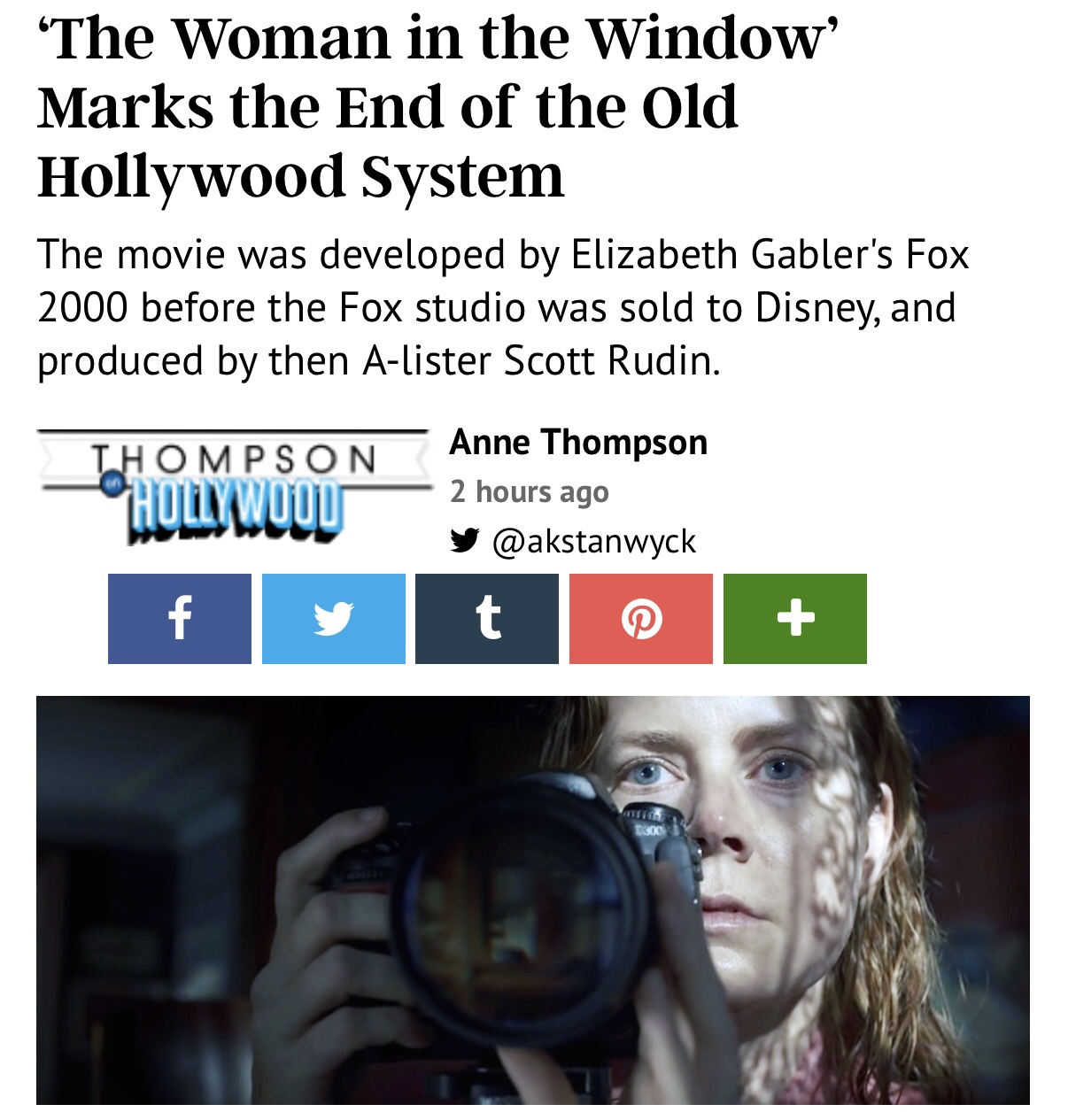Warning: Spoiler material in paragraph #5.
During the first 45 to 50 minutes of The Woman in the Window (Netflix, now streaming) I was saying to myself “hey, this isn’t all that bad…it’s smart, absorbing, carefully composed, shot and cut in fine style and generally kinda nifty.”
Right from the get-go you can feel the presence of Joe Wright, the clever British director who also delivered the audacious Anna Karenina, along with the propulsion of what seems at first like a well-jiggered script, mostly written by Tracy Letts and later tweaked by Tony Gilroy.
There’s also a delicate but highly charged lead performance by Amy Adams, and a dishy one-scene cameo by Julianne Moore. Plus the Hitchcockian references (Rear Window, Spellbound) and hallucinatory flickerings. It’s really quite the package. Until it changes into something else.
I was troubled, I admit, by a weird early scene in which Adams, a wine-sipping, pill-popping, 40something agoraphobic therapist named Anna who lives in a three-story townhouse, is visited by a troubled teenager, Ethan (Fred Heichinger).
Ethan is the son of a bickering, tempestuous couple, Alistair and Jane Russell (Gary Oldman, Julianne Moore), who’ve just moved in across the street, and Anna watches them rant and rave right through their undraped windows. Once Ethan, bearing a small gift from his mom, introduces himself and starts talking jibber-jabbering with Anna, you’re asking himself “is this kid some kind of psycho nutjob? Why’s he so fucking hyper? There’s something Norman Batesy about this guy.”
You’re also asking yourself why Moore is (seemingly) playing a character named Jane Russell. Is there another across-the-street neighbor named Gary Cooper and one around the block named Bob Mitchum? Letts plays Anna’s therapist…what’s his name, Cary Grant?
Spoilers: Anyway I sat up in my seat and began to imagine that the critically panned Woman in the Window might have been misjudged and was actually kinda trippy, as it is during the first 45 or 50.
But then it falls through a trap door when everyone gangs up on Anna/Adams and she folds and confesses to being a delusional fantasist. Another way of putting it is that The Woman in the Window suddenly jumps off a cliff. It goes NUTS. And the climactic third-act scene when a steely-eyed Ethan returns with a knife is CRAY-CRAY.
The problem, in short, is not how Joe Wright directed it — it’s the crazily shifting script. I know Gilroy’s work fairly well, and I know he’s fairly incapable of writing cray-cray so I guess he was stuck between a rock and a hard place and had no choice. It must have been rough on the poor guy.
The whole film, by the way, is set in Harlem (West 124th Street), which makes Woman (critics aren’t allowed to mention this but I can, I think) the first Manhattan Anglo Saxon ensemble film that’s been set north of 110th Street since The Royal Tenenbaums.
In real life Harlem-residing Anglos have been par for the course for at least 15 or 20 years (earlier?), but you’re still struck by the relatively novel setting, at least in traditional movie terms. In all his Manhattan-based films, Woody Allen has never ventured north of 110th or even 96th Street, and no, that doesn’t make him a “bad” person — it makes him an old-fashioned, wise-cracking traditionalist.
Plus early on we hear Adams talking to a friend about her new across-the-street neighbors, and she says they’re “very white.” And then we learn she was previously married to Anthony Mackie‘s Ed Fox, and that they had a daughter (Mariah Bozeman).
And so you’re asking yourself, “What’s going on?” One answer is that Anna just happens to live on West 124th, and she just happened to marry Ed, and that she just happens to be of the opinion that Oldman and Moore are “very white.” And that’s fine.
Another answer is that this is a case of cautionary wokesterism — the producers (Scott Rudin, Eli Bush, Anthony Katagas) and Wright and Letts saying “let’s cover our ass just to be on the safe side.”
One could interpret that this “play it safe” strategy was also behind the creation of a significant inter-racial marriage (Jon Bernthal + Medina Senghore) in Taylor Sheridan and Angelina Jolie’s firefighting film, Those Who Wish Me Dead. A random coincidence or another case of producers saying “let’s game this thing carefully…can’t hurt and nobody will accuse us of anything.”

